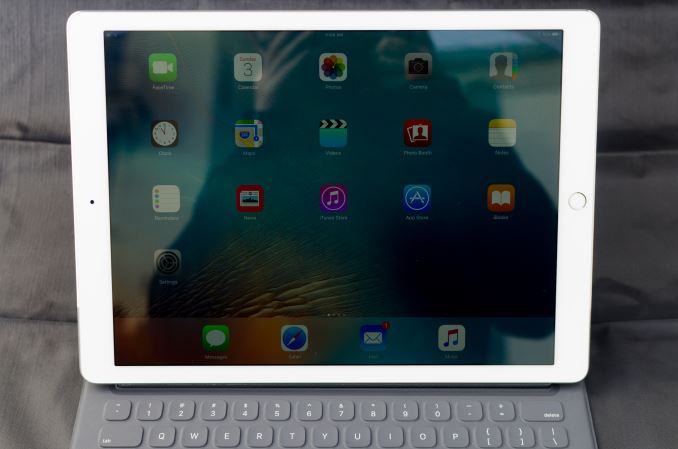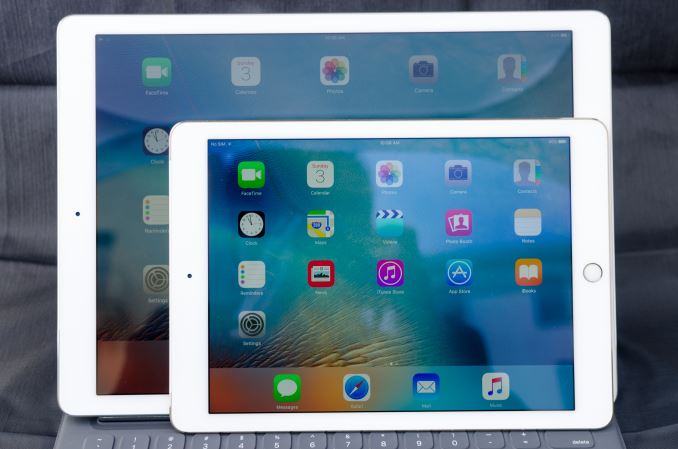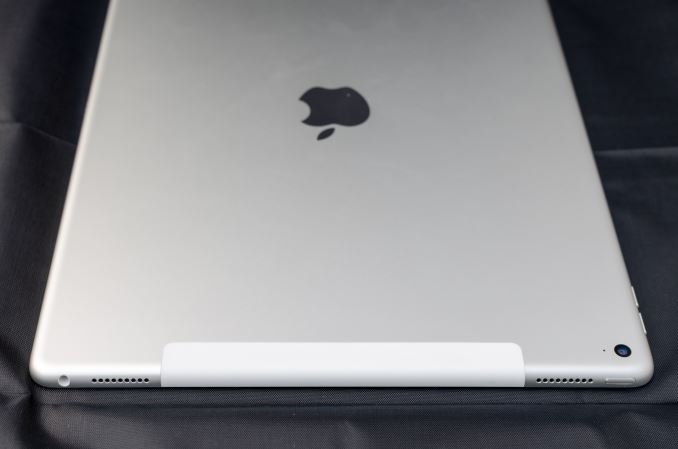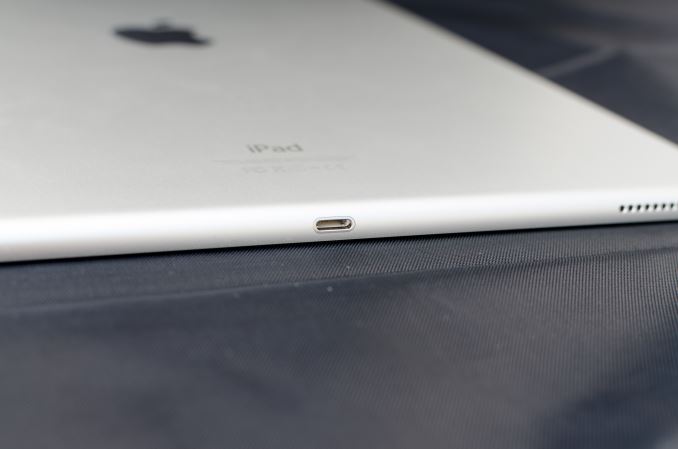The Apple iPad Pro Review
by Ryan Smith, Joshua Ho & Brandon Chester on January 22, 2016 8:10 AM EST
At this point it probably isn’t a secret that tablet sales have leveled off, and in some cases they have declined. Pretty much anywhere you care to look you’ll see evidence that the tablet market just isn’t as strong as it once was. It’s undeniable that touch-only tablets have utility, but it seems that the broader market has been rather lukewarm about tablets. I suspect at least part of the problem here is that the rise of the phablet has supplanted small tablets. Large tablets are nice to have, but almost feel like a luxury good when they’re about as portable as an ultrabook. While a compact laptop can’t easily be used while standing, or any number of other situations where a tablet is going to be better, a compact laptop can do pretty much anything a touch-only tablet can. A laptop is also going to be clearly superior for a significant number of cases, such as typing or precise pointing.
As a result, large touch-only tablets feel like they’ve been limited to home use as a computer away from the computer. Tablets are great when you’re on the couch or in bed, but once you get to this point there are some obvious questions as to whether it makes sense to drop $500+ USD on a tablet that seems to have relatively limited utility. The Surface lineup has been showing signs of growth, but in general the Surface is more of a mix between laptop and tablet rather than a tablet. I would argue that given the OS and overall design that the Surface and Surface Pro are really more laptop than tablet, even if at the hardware level the Surface Pro 4 and Surface 3 are basically tablets with kickstands and keyboard covers.
If you’re guessing that this means Apple has had some issues with growing sales of their iPad lineup, you’d be right. From my first experiences with the iPad 3, I was impressed with the improved user experience for things like web browsing and other smartphone tasks, but I never really felt like it made enough sense to get one for myself. The iPad Air 2 was once again impressive and I felt like I could recommend it to other people that wanted a tablet, but I personally struggled to come up with a reason why I would buy it.
This brings us to the iPad Pro. This is probably the first time Apple has seriously deviated from traditional iPad launches, putting together a tablet built for (limited) productivity and content creation rather than just simple content consumption, creating what's arguably the iPad answer to the Surface Pro. To accomplish this, Apple has increased the display size to something closer to that of a laptop, and we see the addition of a stylus and a keyboard cover for additional precision inputs. Of course, under the hood there have been a lot of changes as well, so the usual spec sheet can be found below to summarize those changes.
| Apple iPad Air 2 | Apple iPad Pro | |
| SoC | Apple A8X 3 x Apple Typhoon @ 1.5GHz |
Apple A9X 2 x Apple Twister @ 2.2GHz |
| GPU | PowerVR 8 Cluster Series6XT (Apple GXA6850) |
PowerVR 12 Cluster Series7XT |
| RAM | 2GB LPDDR3 | 4GB LPDDR4 |
| NAND | 16/64/128GB | 32/128GB |
| Display | 9.7" 2048x1536 IPS LCD | 12.9" 2732x2048 IPS LCD |
| Size and Mass | 240 x 169.5 x 6.1mm 437g WiFi, 444g LTE |
305.7 x 220.6 x 6.9 mm 713g WiFi, 723g LTE |
| Camera | 8MP Rear-Facing, f/2.4, 1.1 micron, 1.2MP Front-Facing, f/2.2 | |
| Battery | 27.3Wh | 38.5Wh |
| Launch OS | iOS 8 | iOS 9 |
| Cellular Connectivity | MDM9x25 Category 4 LTE + GPS/GNSS in Cellular SKU | |
| Other Connectivity | 2x2 802.11a/b/g/n/ac + BT 4.2, Apple Lightning | |
| SIM | Optional NanoSIM | |
| Price | $499/599/699 16/64/128GB | $799/949/1079 32/128GB/128GB LTE |
At a high level, the iPad Pro gains a larger display with a higher resolution, more memory, a new SoC, and a larger battery to compensate for the change in display size. In addition to these changes, the iPad Pro also brings noticeable changes to the speakers, with an increase to four speakers which allow the iPad Pro to compensate for device orientation when projecting stereo audio.
Design
The most immediate change that you can see in the iPad Pro is the sheer size. The 12.9” display of the iPad Pro basically makes it feel like you’re carrying a laptop around. I would argue that this doesn’t actually affect the portability of the iPad Pro, but this is mostly because the iPad Air 2 was something that I only carried in a backpack to begin with. People carrying their tablets in a small bag, purse, or even just in their hands will notice the difference, so the change in size might be more or less noticeable depending upon how you carry things around.
The increase in size does affect weight. After significant use, I honestly don’t think the mass is a significant issue. It does feel heavier than the iPad Air 2, but the mass distribution is such that there isn’t a ton of battery hanging out at the edges of the device where it’ll affect the moment of inertia. This does raise the question of whether Apple included enough battery for sufficient battery life, but that’s a question best left for the rest of the review.
In terms of design, the iPad Pro is rather unremarkable if you’ve ever seen an iPad Air before; it is for all intents and purposes a bigger iPad Air. On the front, the display dominates, with some bezels on the sides and top. The top has the front-facing camera, and the bottom has the home button with TouchID.
Looking at the sides of the tablet, the top edge has the power button and 3.5mm port, along with two of the four speakers. The right edge has the volume buttons, and the bottom edge has the Lightning port and the other two speakers. The left edge is mostly empty, but contains the Smart Connector for the Smart Keyboard and similar accessories.
The back of the tablet is mostly unremarkable as well. For the LTE model, an RF window is visible on the top of the device to allow LTE and other connectivity to function. For the WiFi variants, it looks like the bottom display bezel and the bottom two speakers are the RF windows, so there aren’t any visible areas that indicate where the WiFi antennas are.
Overall, the iPad Pro feels like an iPad, with nothing all that remarkable beyond its size which is carried well. I never really noticed the mass or size of the iPad Pro even if it is clearly larger and heavier than the iPad Air 2. I also didn’t notice any issues with the back cover flexing, but given enough pressure on the back cover pretty much any device this large will see some screen distortion or bending. The iPad Pro does technically regress in thickness compared to the iPad Air 2, but I never noticed the difference in practice, especially when the larger display is really what matters more.
















408 Comments
View All Comments
lucam - Friday, January 22, 2016 - link
Maybe what is really missing (in my opinion) in this review is a bit of more spaces on professional softwares that Apple has created specifically for iPad Pro. Those softwares won't run on iPad Mini and use capabilities of this specific GPU and the Apple Pencil.Don't want to blame Ryan for that as this is the first ''different' tablet ever outside there. But if we really want to put this thing in perspective apart run benchmarks we need to see how does perform with some specific software. For example I would be pretty much interested to see how the Cad tool run on it.
id4andrei - Friday, January 22, 2016 - link
"they have been closing the architecture and manufacturing gap with Intel" - on architecture yes, but on manufacturing you have the wrong party, that is TSMC, not Apple.On stylus testing. So, you cannot possibly draw a straight diagonal on Windows? Are you sure you have tested the Surface Pen as extensively as you tested the Pencil?
JoshHo - Friday, January 22, 2016 - link
We understand that TSMC is the foundry, but to some extent customers do guide foundry roadmap and process spec. TSMC is not making new processes in a vacuum to our understanding.Regarding the stylus the Surface Pro 4 and other N-Trig devices have an issue where trying to draw a straight diagonal will cause wavy lines. The SP4 does improve on this over the SP3, but it's still not quite perfect compared to iPad Pro which doesn't have this issue at all.
id4andrei - Friday, January 22, 2016 - link
I am compelled to thank you for your utterly prompt reply. My toying with the SP2's Wacom based stylus certainly cannot be equivalent to the recent tech used by MS.Sensitivity levels is an area I haven't seen discussed. Judging by the wording in the review, it's good enough that's imperceptible compared to Wacom's.
JoshHo - Saturday, January 23, 2016 - link
To my knowledge the SP2 and SP1 Wacom styluses are better than the N-Trig styluses in some ways still. However for people that are looking to buy a new Surface Pro or Surface there isn't really an option to use a Wacom stylus.rubene66 - Friday, January 22, 2016 - link
No Pixel C comparison why!Ryan Smith - Friday, January 22, 2016 - link
Check back on Monday,=)snuffysasa - Friday, January 22, 2016 - link
Question: I want to know how much watts, what TDP is the A9X? we know core-M is 4.5W how much is A9X? thanksI have been wanting to know the answer to this question since the iPad Pro was announced
JoshHo - Friday, January 22, 2016 - link
We don't know the exact TDP of A9X, and TDP across silicon vendors isn't comparable. However it's roughly comparable based upon the power consumption seen in our power virus tests.10101010 - Friday, January 22, 2016 - link
Thanks for putting together such a high quality review. I've talked to a few people at work with iPad Pros and they are all using them as a "paper and pencil" replacement. This is not just for taking notes, but also for annotating presentations and research papers. Reading PDF files also works very well, although an OLED screen would be nice for night time reading (in inverse mode). Some of the people I talked to have owned Windows tablets in the past and they rave about how well the Apple Pencil works. All in all, I'm quite impressed with the iPad Pro. It's a great tablet.